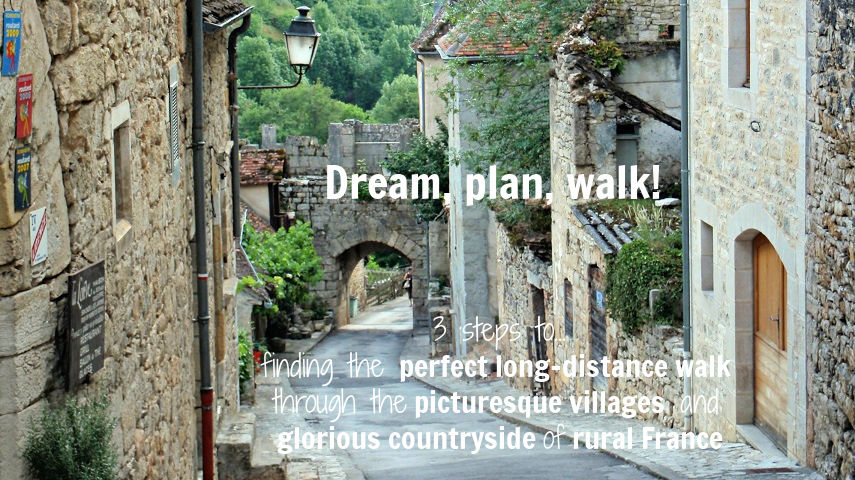
(Published November 2017, last updated April 2025)
Forty-two days of walking through southern France along the Chemin de Saint-Jacques from Le Puy-en-Velay to Saint-Jean-Pied-de-Port.
Follow the footsteps of the first pilgrims over the wide-open spaces of the Aubrac plateau, through the Célé valley to the foothills of the Pyrénéan mountains, visiting eleven of France’s ‘most beautiful villages’ and dozens of ancient chapels, abbeys and cloisters.
Do it all or just one section—practical tips, map, highlights, suggested itinerary (plus faster alternatives) and 40+ photos to plan the perfect walk.
Chemin de Saint-Jacques du-Puy map
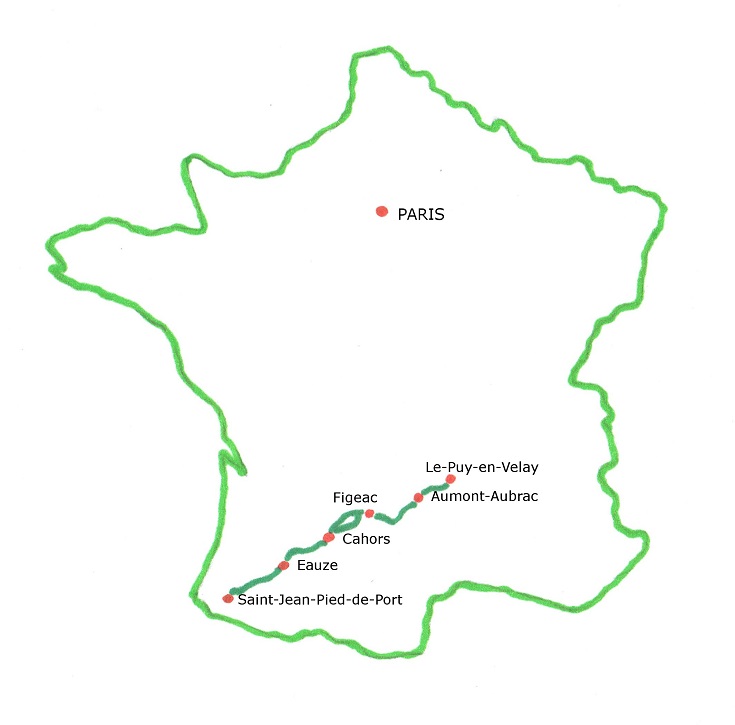
Walking the GR 65 Chemin de Saint-Jacques du-Puy, France …
The GR 65 stretching from Le Puy-en-Velay to Saint-Jean-Pied-de-Port in southern France is known by many names—the Way of Saint James, Via Podiensis, Chemin de Saint-Jacques, Saint-Jacques de Compostelle and, more simply, the Pilgrims’ Trail.
It’s an ancient trail, followed by thousands of walkers each year since the tenth century. (Read a little bit about the history of the Chemin de Saint-Jacques.)
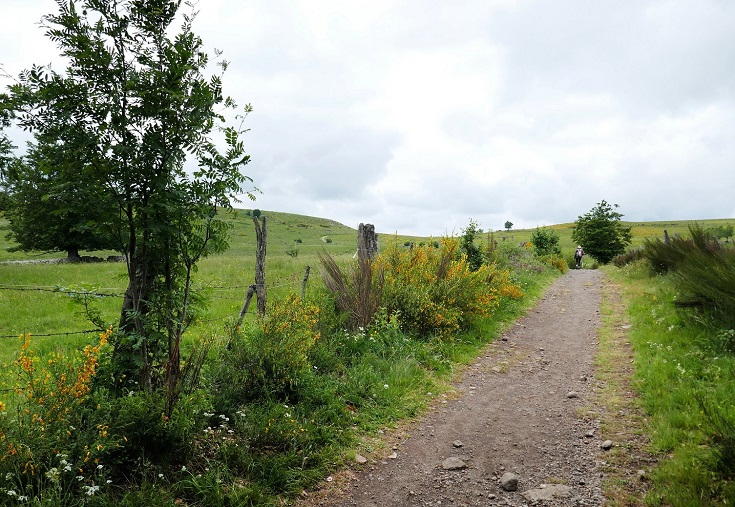
The path between Aubrac and Saint-Chély-d’Aubrac (Stage 2: Aumont-Aubrac to Figeac)
It holds a special place in my heart as it was my first experience of long-distance walking in France, although I confess that I started in the middle and returned in later years to walk the first and last sections.
In the summer of 2022, I returned to walk the chemin in the ‘correct’ order. With the luxury of six full weeks to complete the journey, I took my time, staying the night in villages I hadn’t stopped in before and spending several afternoons exploring towns I’d rushed through in the past.
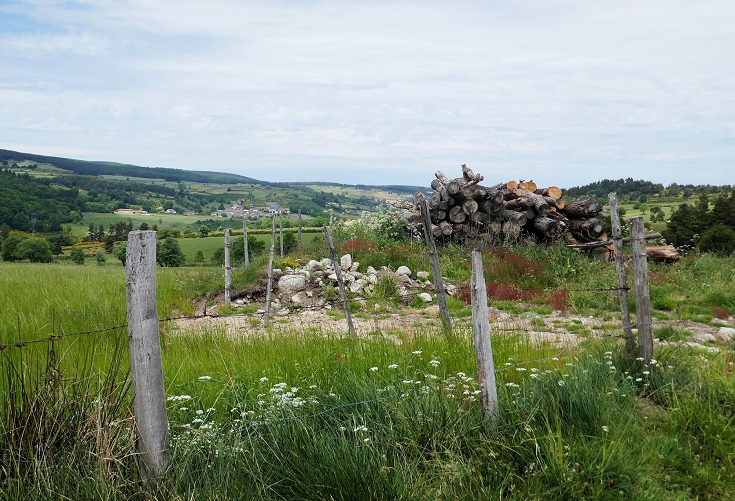
Looking back to Villeret-d’Apchier (Stage 1: Le Puy-en-Velay to Aumont-Aubrac)
Chemin de Saint-Jacques du-Puy itinerary
I’m very much an ‘enjoy breakfast, walk a few hours, have a nice lunch, walk another few hours and linger over dinner’ kind of girl.
For me, long-distance walking is about slowing down, admiring the scenery and relishing the clean fresh air. I find it hard to walk past an ancient chapel without taking at least a cursory look around, and relaxing over a coffee or an Orangina in one of France’s ‘most beautiful villages’ is my idea of heaven.
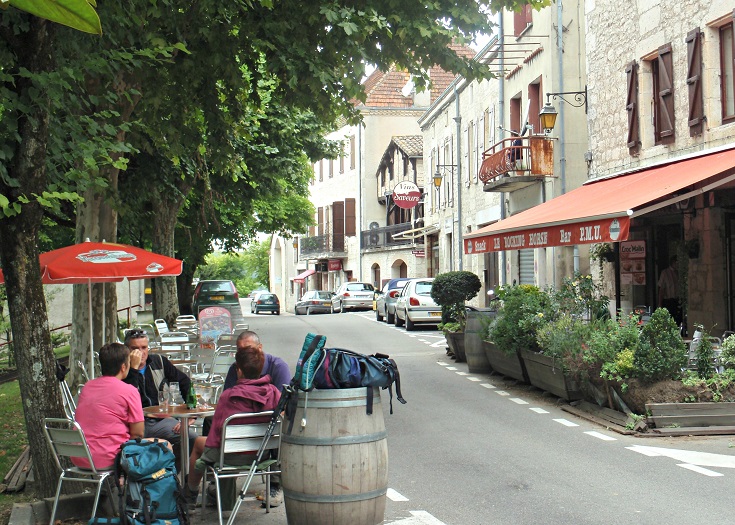
I love participating in a journey that thousands of walkers have taken before me and imagining how life on the trail would have been centuries ago.
Because the first thirty-five kilometres (twenty-two miles) from Le Puy-en-Velay to Montaure (just past Monistrol-d’Allier) include some strenuous climbing, I recommend starting with a slower pace and spreading the first stage of 88 kilometres (55 miles) over six days. This schedule allows plenty of time to loosen up your leg muscles and ease into a comfortable walking rhythm, to notice any hotspots on your feet and take precautionary measures before blisters form, and to make final adjustments to your backpack before tackling any longer days.
The traditional path along the Chemin de Saint-Jacques follows the GR 65 from Le Puy-en-Velay to Saint-Jean-Pied-de-Port—a total distance of 740 kilometres (463 miles).
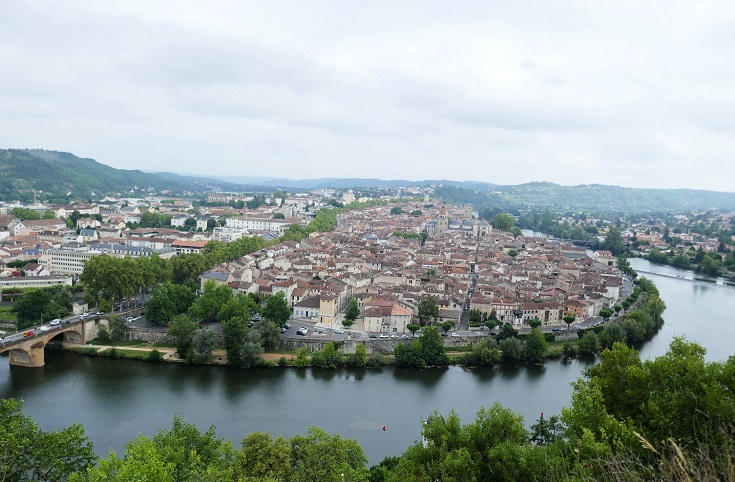
The GR 36 path (Célé variante) approaches Cahors, offering magnificent views of the town from Mont-Saint-Cyr
A popular choice among walkers is the Célé variante which leaves the GR 65 ten kilometres (six miles) past Figeac and takes a more northerly route, following the GR 651 to its finish at Bouziès. Here it meets the GR 36—GR 46 which heads south to rejoin the GR 65 near Bach, 27 kilometres (17 miles) before Cahors. This variante adds 26 kilometres to the walk (a total distance of 766 kilometres/480 miles) but rewards you with visits to the ruins of an abbey (at Marcilhac-sur-Célé), underground caves (at Pech Merle, Cabarerets) and another of France’s ‘most beautiful villages’ (Saint-Cirq-Lapopie).
The itinerary below enjoys all the highlights of the Célé variante but instead of heading south along the GR 36—GR 46 to rejoin the GR 65, it follows the GR 36 west, taking a more direct route to Cahors. This reduces the walk by five kilometres (three miles) to a total distance of 761 kilometres (476 miles).
Look inside the CHEMIN DE SAINT-JACQUES DU-PUY (PDF) guidebooks
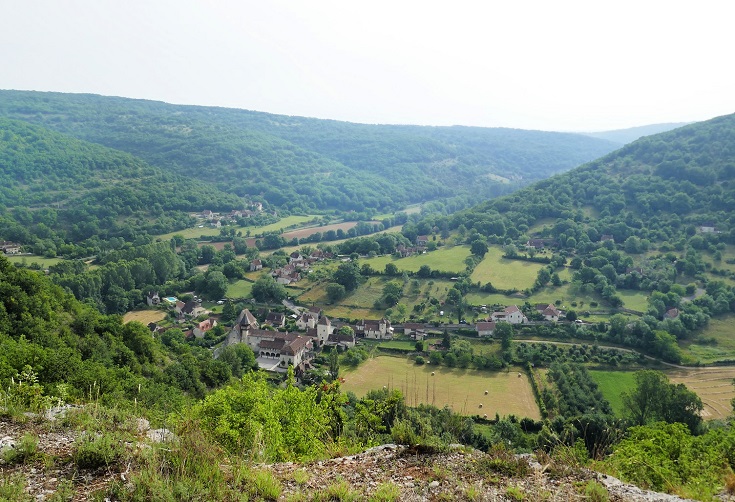
The Célé variante is a strenuous path, climbing the ridge before descending to each of the villages located along the river. The reward is the fabulous views, in this case down to Espagnac-Sainte-Eulalie.
Stage 1: Le Puy-en-Velay to Aumont-Aubrac (88.5 km/55.3 mi)
Day 1: Le Puy-en-Velay to Montbonnet (15.5 km/9.7 mi)
Day 2: Montbonnet to Monistrol-d’Allier (14.5 km/9.1 mi)
Day 3: Monistrol-d’Allier to Saugues (12 km/7.5 mi)
Day 4: Saugues to Chazeau (15.5 km/9.7 mi)
Day 5: Chazeau to Saint-Alban-sur-Limagnole (17 km/10.6 mi)
Day 6: Saint-Alban-sur-Limagnole to Aumont-Aubrac (14 km/8.8 mi)
Stage 2: Aumont-Aubrac to Figeac (163 km/101.9 mi)
Day 7: Aumont-Aubrac to Montgros (23.5 km/14.7 mi)
Day 8: Montgros to Aubrac (12 km/7.5 mi)
Day 9: Aubrac to Saint-Côme-d’Olt (24 km/15 mi)
Day 10: Saint-Côme-d’Olt to Espalion (8 km/5 mi)
Day 11: Espalion to Estaing (12.5 km/7.5 mi)
Day 12: Estaing to Espeyrac (23 km/14.4 mi)
Day 13: Espeyrac to Conques (12.5 km/7.8 mi)
Day 14: Conques to Livinhac-le-Haut (22.5 km/14.1 mi)
Day 15: Livinhac-le-Haut to Figeac (25.5 km/15.9 mi)
Stage 3: Figeac to Cahors (108.2 km/67.6 mi) following the Célé variante
Day 16: Figeac to Espagnac-Sainte-Eulalie (24.3 km/15.2 mi)
Day 17: Espagnac-Sainte-Eulalie to Marcilhac-sur-Célé (15 km/9.4 mi)
Day 18: Marcilhac-sur-Célé to Cabrerets (19 km/11.9 mi)
Day 19: Cabrerets to Saint-Cirq-Lapopie (11 km/6.9 mi)
Day 20: Saint-Cirq-Lapopie to Vers (19.3 km/12.1 mi)
Day 21: Vers to Cahors (19.6 km/12.3 mi)
Stage 4: Cahors to Eauze (193.3 km/120.8 mi)
Day 22: Cahors to Lascabanes (24.5 km/15.3 mi)
Day 23: Lascabanes to Lauzerte (23.5 km/14.7 mi)
Day 24: Lauzerte to Espis (23.3 km/14.6 mi)
Day 25: Espis to Moissac (3.7 km/2.3 mi)
Day 26: Moissac to Auvillar (21 km/13.1 mi)
Day 27: Auvillar to Flamarens (13.3 km/8.3 mi)
Day 28: Flamarens to Lectoure (19 km/11.9 mi)
Day 29: Lectoure to La Romieu (19 km/11.9 mi)
Day 30: La Romieu to Condom (13 km/8.1 mi)
Day 31: Condom to Montréal (17 km/10.6 mi)
Day 32: Montréal to Eauze (16 km/10 mi)
Stage 5: Eauze to Saint-Jean-Pied-de-Port (208.5 km/130.3 mi)
Day 33: Eauze to Nogaro (20 km/12.5 mi)
Day 34: Nogaro to Aire-sur-l’Adour (27.5 km/17.2 mi)
Day 35: Aire-sur-l’Adour to Pimbo (26.5 km/16.6 mi)
Day 36: Pimbo to Larreule (19 km/11.9 mi)
Day 37: Larreule to Arthez-de-Béarn (17.9 km/11.2 mi)
Day 38: Arthez-de-Béarn to Sauvelade (18.1 km/11.3 mi)
Day 39: Sauvelade to Navarrenx (13.7 km/8.6 mi)
Day 40: Navarrenx to Aroue (19.6 km/12.2 mi)
Day 41: Aroue to Harambeltz (20.2 km/12.6 mi)
Day 42: Harambeltz to Saint-Jean-Pied-de-Port (26 km/16.2 mi)
If you prefer to go a little faster, the walk can be completed quite comfortably in 34 days. You’ll find alternative itineraries and a comprehensive list of villages offering accommodation at each of the stages below. You’ll also find suggestions for rest days (or lazy afternoon days) and sights worth taking some time to enjoy.
Stage 1: Le Puy-en-Velay to Aumont-Aubrac (88.5 km/55.3 mi in four days)
Stage 2: Aumont-Aubrac to Figeac (163 km/101.9 mi in eight days)
Stage 3: Figeac to Cahors (87.3 km/54.6 mi in four days) following the GR 65
Stage 4: Cahors to Éauze (193.3 km/120.8 mi in nine days)
Stage 5: Éauze to Saint-Jean-Pied-de-Port (208.5 km/130.3 mi in nine days)
Look inside the CHEMIN DE SAINT-JACQUES DU-PUY (PDF) guidebooks
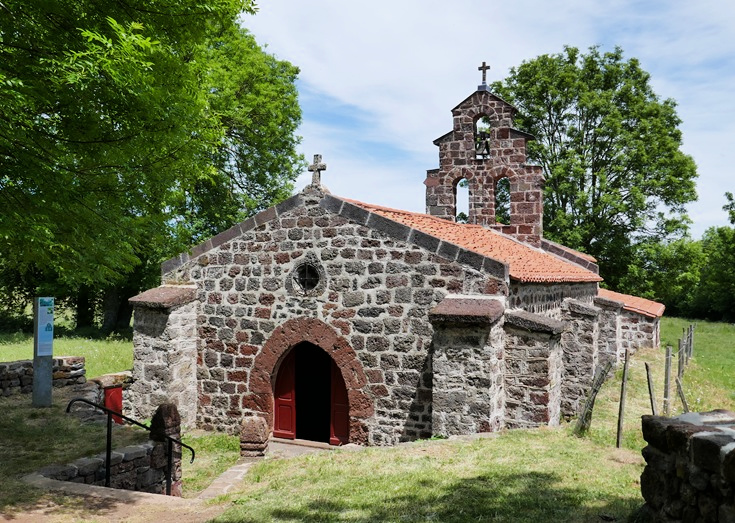
Chapelle Saint-Roch, near Montbonnet (Stage 1: Le Puy-en-Velay to Aumont-Aubrac)
Highlights of the Chemin de Saint-Jacques du-Puy
Every day of walking along the Chemin de Saint-Jacques du-Puy brings new delights—an ancient chapel, an abandoned château, a roadside memorial hung with rosary beads, a tiny medieval village, spectacular scenery (always spectacular scenery!) and good food at the end of the day!
What can you expect walking along this historic trail?
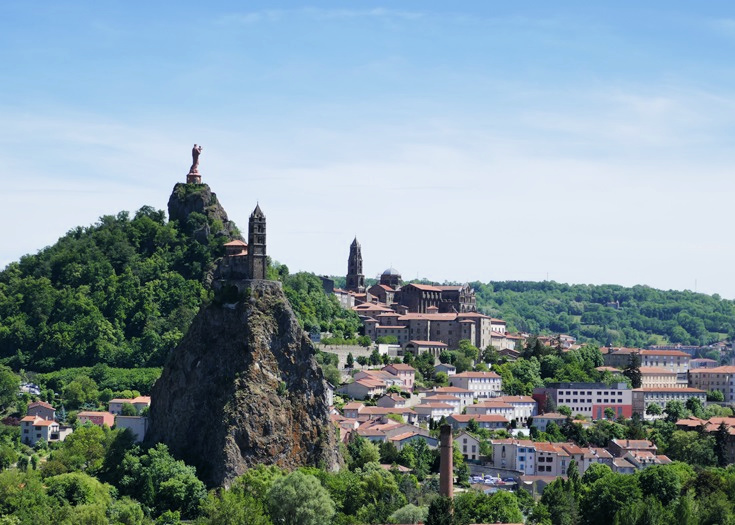
Rocher Saint-Michel, Statue Notre-Dame de France and Cathedrale Notre-Dame dominate the skyline of Le Puy-en-Velay
Le Puy-en-Velay (starting point of the Chemin de Saint-Jacques)
Take a day, or two, before you start walking to explore Le Puy-en-Velay.
There are many charming corners to discover, including the twelfth century Cathédrale Notre-Dame du Puy with its adjoining cloister, Statue Notre-Dame de France built from the metal of Russian cannons captured during the Crimean War and a tiny chapel which has stood high on top of Rocher Saint-Michel d’Aiguilhe since 961 CE.
Take a closer look around Le Puy-en-Velay and find a comprehensive list of accommodation.
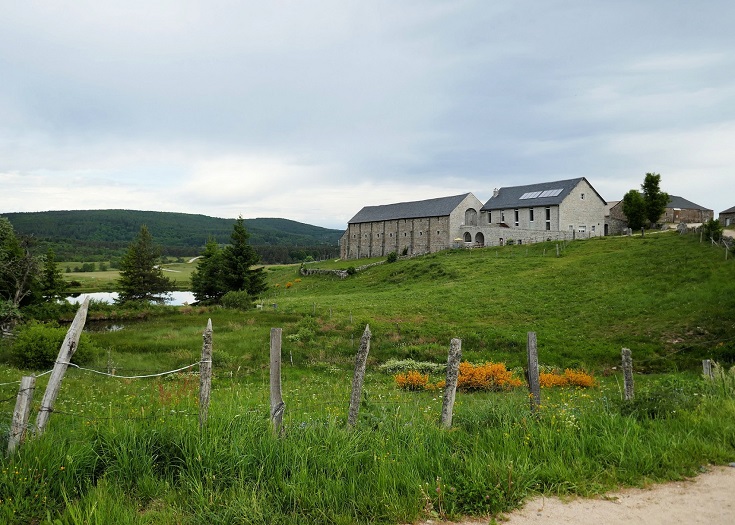
Domaine le Sauvage
Le Sauvage (Stage 1: Le Puy-en-Velay to Aumont-Aubrac)
A little over 60 kilometres (almost 40 miles) beyond Le Puy-en-Velay, the Chemin de Saint-Jacques reaches the gîte at Le Sauvage, considered by many as a ‘must-do’ overnight stop.
Domaine le Sauvage en Gévaudan can accommodate 41 people and, each night, serves a delicious meal prepared from food produced on the surrounding farms. Great importance is placed on sustainable farming practices and showing respect for the memory and spirit of the original hostel by providing pilgrims with a friendly welcome and a nourishing meal.
Learn more about the history of Le Sauvage and find a comprehensive list of nearby accommodation.
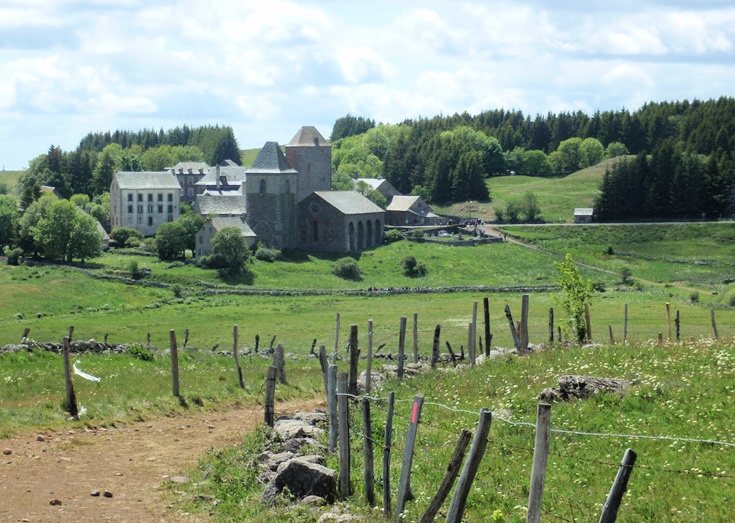
Approaching the village of Aubrac
Aubrac (Stage 2: Aumont-Aubrac to Figeac)
If there is one section of the Chemin de Saint-Jacques that I’d like to walk over and over, it’s the stretch leading to the tiny village of Aubrac. Although many of the medieval buildings have long disappeared, the view of the church tower surrounded by ancient stone houses never fails to set my heart aflutter!
Take a closer look around Aubrac and find a comprehensive list of accommodation.

Beyond Saint-Chély-d’Aubrac, the GR 65 climbs a gentle ridge offering views back to the village
Saint-Chély-d’Aubrac (Stage 2: Aumont-Aubrac to Figeac)
Saint-Chély-d’Aubrac is the quintessential rural French village, boasting a school, a café and several options for an overnight stay. Although it feels quite modern after the medieval charm of Aubrac, the church dates from the fourteenth century and the turrets and towers are a reminder that village life has been going on here for many centuries.
Take a closer look around Saint-Chély-d’Aubrac and find a comprehensive list of accommodation.
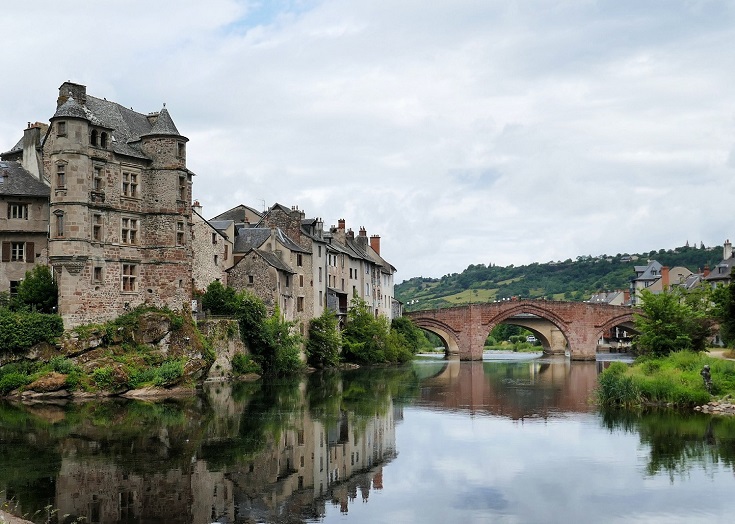
Medieval charm of Vieux Palais and Pont-Vieux greets walkers arriving in Espalion
Espalion (Stage 2: Aumont-Aubrac to Figeac)
Spend an hour or two wandering the streets of this beautiful town with its fairy-tale turrets, medieval bridge and ancient tanneries lining the river.
If you are following my suggested itinerary, you’ll arrive in Espalion with the afternoon free and plenty of time to wander the streets, visit the museum honouring Auguste Denayrouze and Benoît Rouquayrol who lived nearby and invented the first modern diving equipment, and admire the richly decorated baroque interior of Chapelle des Pénitents.
Take a closer look around Espalion and find a comprehensive list of accommodation.
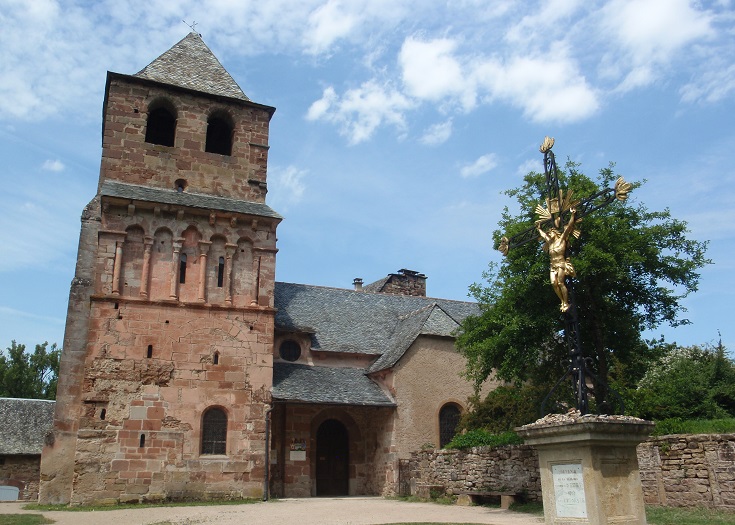
L’église Saint-Pierre in Bessuéjouls
Église Saint-Pierre in Bessuéjouls (Stage 2: Aumont-Aubrac to Figeac)
Venture inside Église Saint-Pierre in the hamlet of Bessuéjouls and climb the twelfth-century bell tower to the tiny chapel dedicated to Saint-Michel. The views are lovely but the history oozing from the stone walls is almost palpable.
Take a closer look inside Église Saint-Pierre and find a comprehensive list of accommodation nearby.
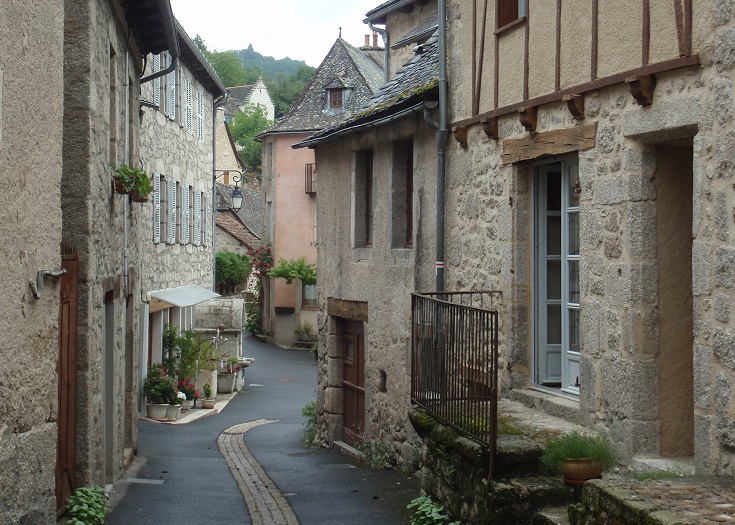
Quaint alley in Espeyrac
Espeyrac (Stage 2: Aumont-Aubrac to Figeac)
I love the tiny village of Espeyrac with its narrow, crooked laneways. There’s almost nothing here other than the church, the hotel and a few dozen houses so be sure to take a half hour and explore them all.
Take a closer look around Espeyrac and find a comprehensive list of accommodation.
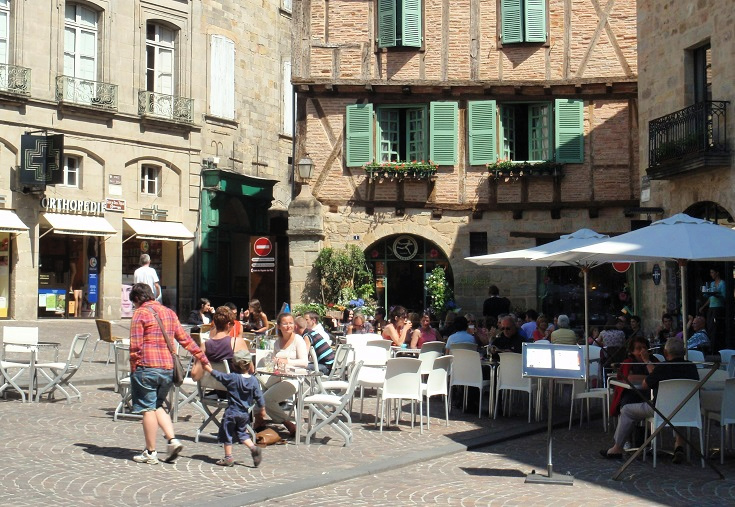
Place Champollion in Figeac
Figeac (Stage 2: Aumont-Aubrac to Figeac)
If you are ready for a rest day or two, the bustling market town of Figeac is the ideal place to stop awhile and restock before exploring the surrounding area.
When you’ve had your fill of museums (Jean-François Champollion, who first deciphered the hieroglyphics of the Rosetta Stone, was born here) and medieval architecture, rent a car (or take a train or a taxi) to visit nearby Rocamadour and the underground lakes and caves at Gouffre de Padirac.
Take a closer look around Figeac and find a comprehensive list of accommodation.
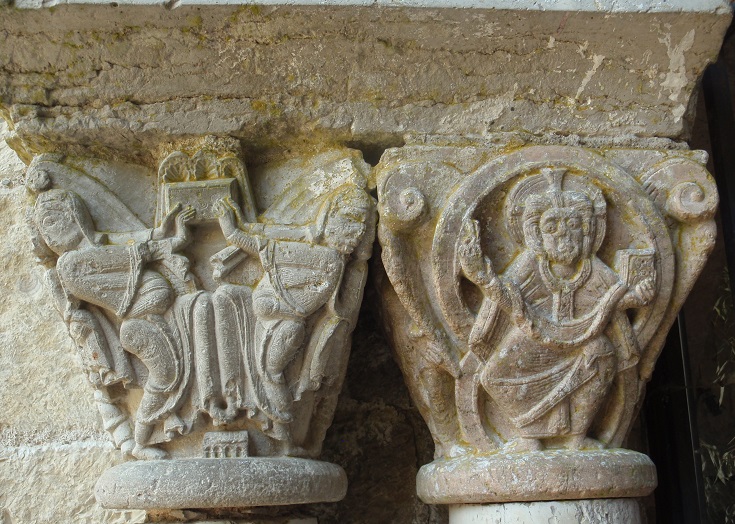
Capitals in the ruins of the abbey in Marcilhac-sur-Célé
Marcilhac-sur-Célé (Stage 3: Figeac to Cahors, Célé variante)
Long ago, in the tenth century, Benedictine monks built an abbey in a clearing in the forest beside the Célé River and lived there in peace for four hundred years.
Attacks by the English over the next two centuries of war inflicted irreparable damage and all that remains intact today is the Chapter House where the monks met each day. Enough of the structure remains to evoke a deep sense of the history and events that have occurred here, including a well-preserved tympanum from the eleventh century depicting Christ sitting above Saint Peter and Saint Paul.
Take a closer look around Marcilhac-sur-Célé and find a comprehensive list of accommodation.
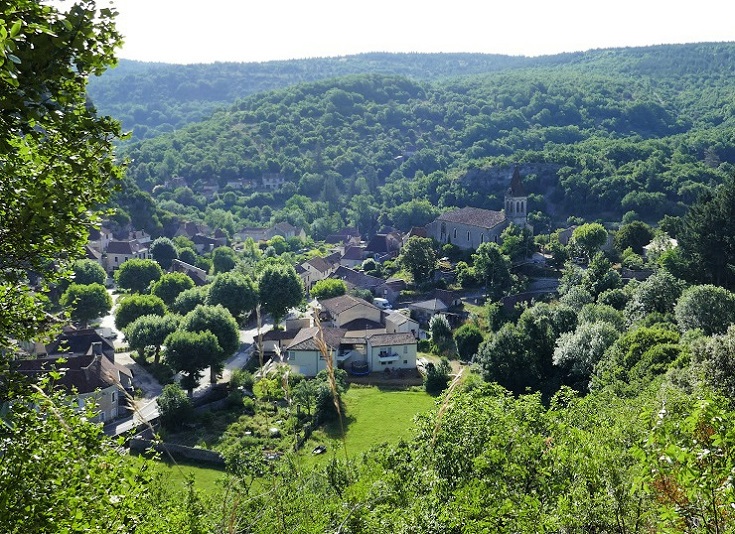
The village of Cabrerets, viewed from Pech Merle
Pech Merle (Stage 3: Figeac to Cahors, Célé variante)
This set of underground caves stretching two kilometres (1.2 miles) in length, includes some of the most beautifully preserved pre-historic rock paintings and natural rock formations in all of France. Book in advance as entrance to Pech Merle is limited to 700 visitors each day.
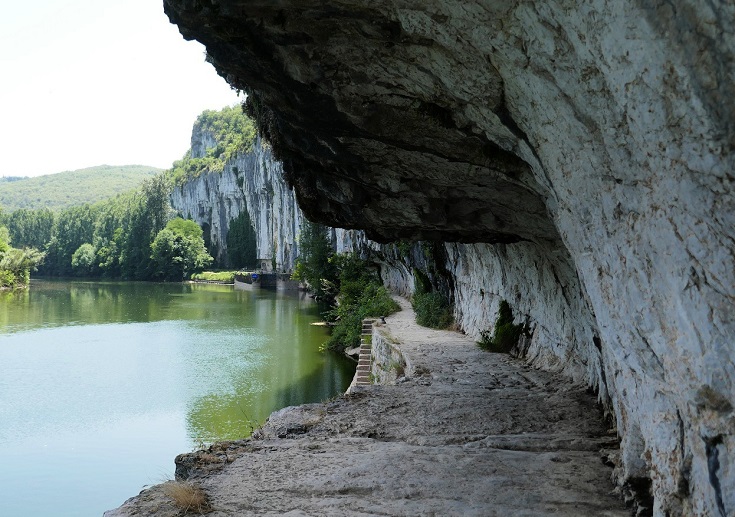
Chemin de Halage, between Bouziès and Saint-Cirq-Lapopie
Chemin de Halage (Stage 3: Figeac to Cahors, Célé variante)
Between Bouziès and Saint-Cirq-Lapopie, the path follows the Lot River which, in the Middle Ages, was the primary route for transportation for goods throughout the area. Flat bottomed barges carried regional produce west towards Bordeaux on the Atlantic Coast and returned with goods which were not available locally. On the return journey, teams of men or horses were needed to haul the barges against the upstream currents.
In one section, more than one kilometre in length, steep cliffs rose abruptly from the river’s edge and a towpath was carved from the rock, allowing the men and horses to continue their walk.
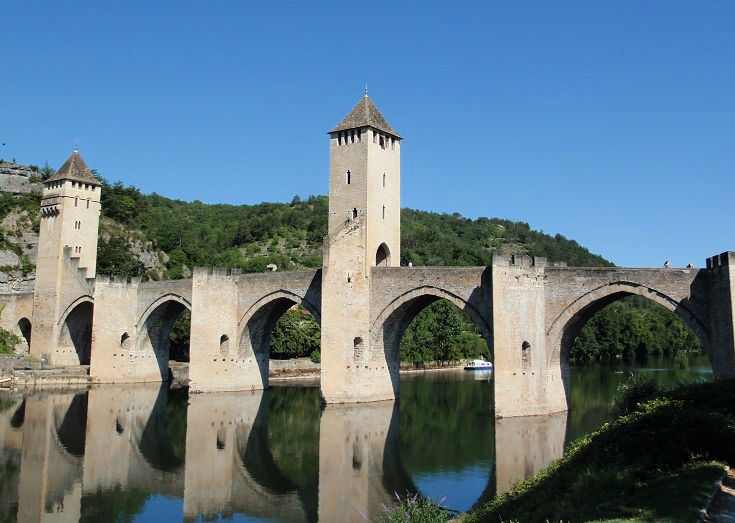
Pont Valentré, Cahors
Cahors (Stage 3: Figeac to Cahors)
It’s time to take another rest day and head out to the nearby wineries! The vineyards surrounding Cahors are famous for producing superb Malbec wines and tours available from the Tourist Office will guide you on an afternoon of sampling the best the region has to offer.
Before leaving Cahors, call in to the Musée de la Résistance (check the opening hours at the Tourist Office as the museum has recently undergone renovations). We were lucky enough to be guided around the museum by a lady who lived here as a young girl during WWII. She brought the stories of the people who risked, and sometimes lost, their lives aiding the Allies to life in a way that was both harrowing and inspiring!
Take a closer look around Cahors and find a comprehensive list of accommodation.
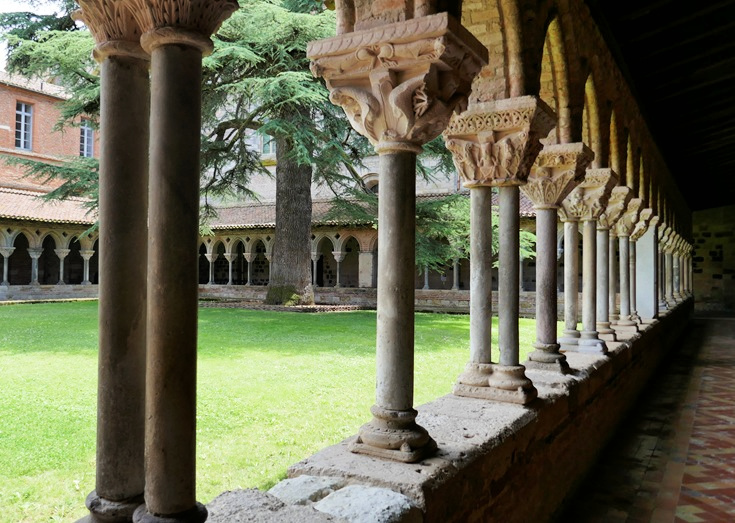
Seventy-six capitals adorning the columns lining the cloister in Moissac
Moissac (Stage 4: Cahors to Eauze)
I’m a sucker for a nice cloister and will spend far too much time wandering their dim corridors and soaking up the peace and tranquillity. The twelfth-century cloister adjoining the cathedral in Moissac is particularly lovely and the 76 capitals mounted on alternating single and double columns are believed to be the oldest in the world.
Take a closer look around Moissac and find a comprehensive list of accommodation.
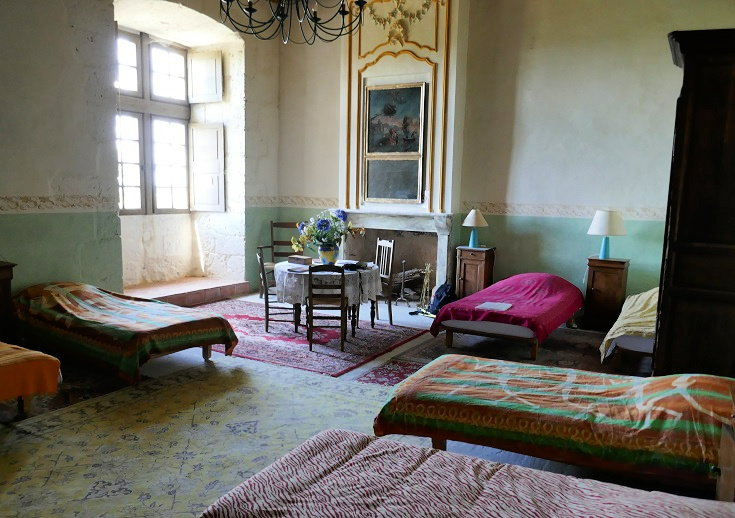
Overnight accommodation at Château de Flamarens offers a glimpse into life inside a fortified château
Flamarens (Stage 4: Cahors to Eauze)
Dominating the village of Flamarens is an imposing thirteenth-century château. At the end of the Hundred Years War in 1469, the château was enlarged and luxuriously decorated in a sumptuous display of wealth and prosperity. By the beginning of the twentieth century, the château was deserted and had fallen into disrepair, and in the summer of 1943, the roofs were destroyed when lightning ignited a fierce fire.
In 1983, the derelict château was bought by the Gadel family who have lovingly restored the lower floors and now offer overnight accommodation—which I can thoroughly recommend! (A double room is available in addition to two six-bed rooms.)
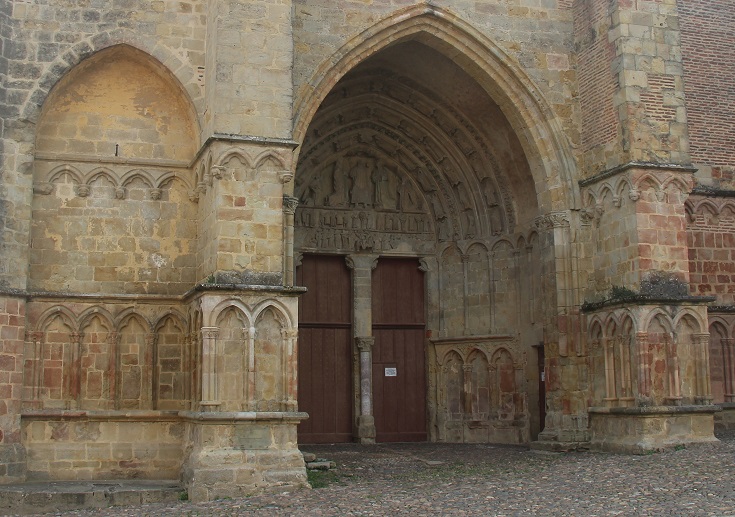
Exquisitely carved exterior of Saint-Quitterie in Aire-sur-l’Adour
Aire-sur-l’Adour (Stage 5: Eauze to Saint-Jean-Pied-de-Port)
At the top of the hill leaving Aire-sur-l’Adour, you’ll pass by the church dedicated to Sainte-Quitterie. Inside is the tomb of a fifth-century princess, who was decapitated by her fiancée when she refused to denounce her Christian faith and marry him. In the eleventh century, her head was brought to this place on the hill, where monks built the basilica in her honour.
The doors to the church are sometimes locked, but guided visits are held throughout the week between mid-June and mid-September. Ask at the Tourist Office (or check the guidebook) about tour times and reserving your place.
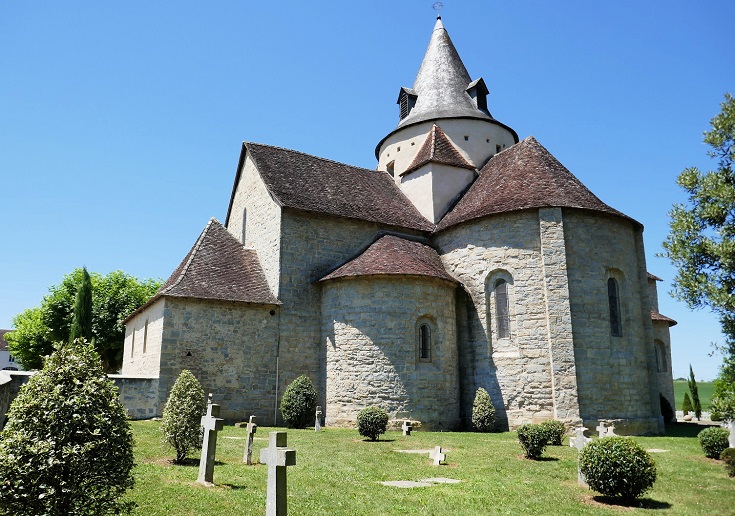
Abbaye de Sauvelade
Abbaye de Sauvelade (Stage 5: Eauze to Saint-Jean-Pied-de-Port)
In the twelfth century, Gaston IV, the first knight to enter Jerusalem during the Crusades, returned home from battle, dismayed by the senseless massacres he’d witnessed. He ordered the construction of several hostels and chapels to provide shelter for pilgrims headed to Santiago. In 1128, he gifted Abbaye de Sauvelade to an order of Benedictine monks and the abbey became an important stage on the Chemin de Saint-Jacques.
In recent years, extensive restorations have returned the abbey to its former glory. Call inside and admire the beautifully decorated interior chapels and enjoy a short film chronicling the restoration of the abbey and its role in the community.
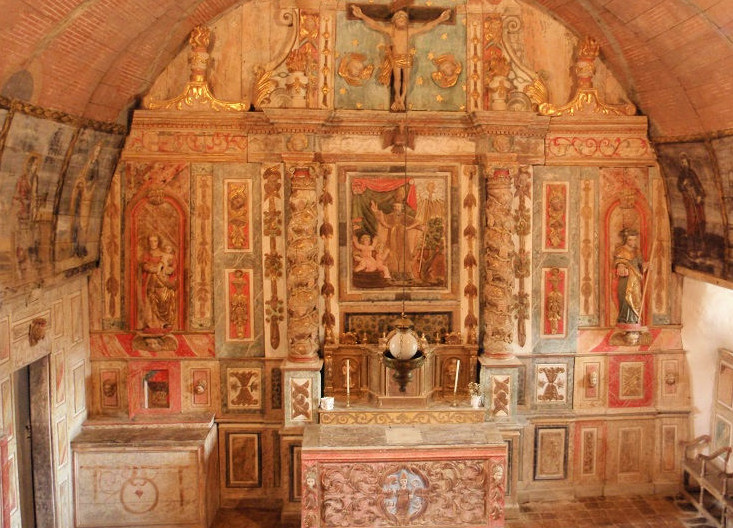
Stunning baroque interior of Église Saint-Nicolas in Harambeltz
Harambeltz (Stage 5: Eauze to Saint-Jean-Pied-de-Port)
For me, Église Saint-Nicolas in the tiny hamlet of Harambeltz is perhaps the highlight of the Chemin de Saint-Jacques. Nestled among the farmhouses and cowsheds, its simple stone walls hide a meticulously restored baroque interior.
My first visit inside Église Saint-Nicolas was in 2011, but since 2019, the church doors are only opened to visitors on Thursday between 2 pm and 6 pm, or for groups of ten or more visitors who have made prior arrangement.
In July 2022, I booked a bed at the gîte, aware that a visit inside the church was unlikely to eventuate. Late in the afternoon, a large group of Boy Scouts arrived and pitched their tents around the church grounds. You can imagine my delight when, later that evening, our host announced that doors to the church were open and we were welcome to call in! I will keep my fingers crossed that such good luck awaits you also!
Take a closer look around Harambeltz and find a comprehensive list of accommodation.
Look inside the CHEMIN DE SAINT-JACQUES DU-PUY (PDF) guidebooks
Visit eleven of the ‘most beautiful villages’ in France
Formed in 1982, with the aim of protecting and promoting the heritage and beauty of small towns throughout France, the association of Les Plus Beaux Villages de France has grown to include 180 villages scattered throughout the country.
Along the Chemin de Saint-Jacques du-Puy, you’ll visit eleven of France’s ‘most beautiful villages’:
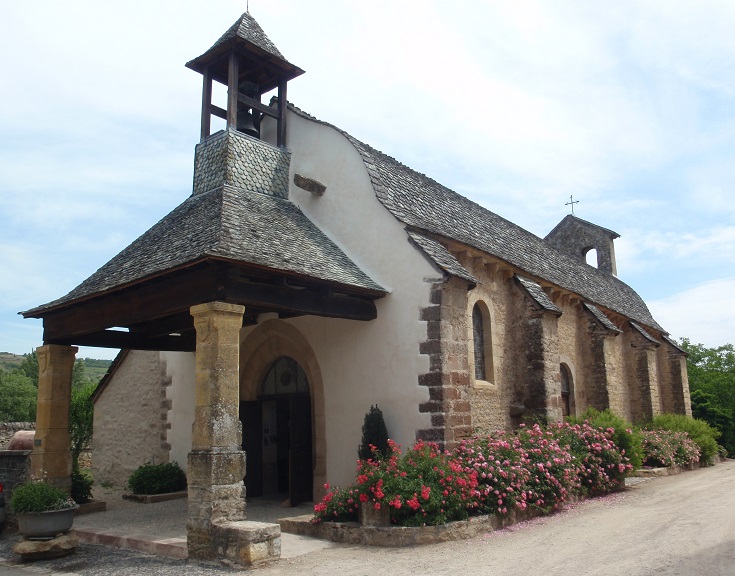
Twelfth-century Chapelle des Penitents, Saint-Côme-d’Olt
Saint-Côme-d’Olt (Stage 2: Aumont-Aubrac to Figeac)
Saint-Côme-d’Olt is dotted with interesting historical monuments, mostly located a block or two from the GR 65 path. Ask for a map at the Tourist Office (or download one from the link below) so you don’t miss any!
As you follow the map, you’ll visit the twelfth-century Chapelle des Pénitents, l’Oradou—a small monument honouring victims of the 1586 plague that claimed the lives of three-quarters of the population, and pass through the old gates which guarded entrance to the town.
Take a closer look around Saint-Côme-d’Olt and find a comprehensive list of accommodation.
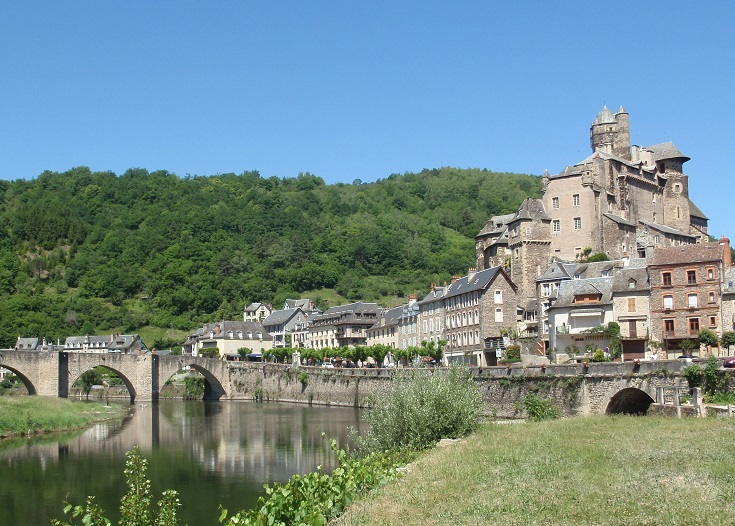
Château d’Estaing dominates the village
Estaing (Stage 2: Aumont-Aubrac to Figeac)
Located on the far side of the river from the GR 65 path and dominated by an imposing eleventh-century château, the village of Estaing begs to be explored. I recommend arriving after a short day of walking from Espalion that leaves the afternoon free to relax, visit the church and wander through the maze of narrow streets.
Allow an hour or two to explore the château which has been owned by the family of Valéry Giscard d’Estaing (President of France from 1974 to 1981) since 2005. Some of the rooms that are open to the public display an exhibition dedicated to his life and career, while others provide information about the room’s original use.
Take a closer look around Estaing and find a comprehensive list of accommodation.
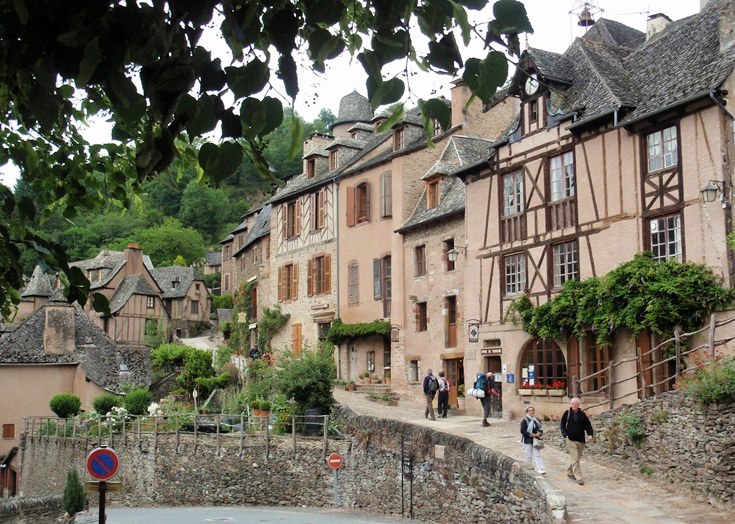
Medieval houses in Conques
Conques (Stage 2: Aumont-Aubrac to Figeac)
A charmingly ramshackle collection of stone and timber houses clustered around the magnificent abbey church, the village of Conques is not to be rushed through. Inside the church lay the relics of Sainte-Foy, a thirteen-year-old girl who was martyred in 303 CE in nearby Agen for her refusal to denounce her Christian faith. In 866 CE, the relics of Sainte-Foy were ‘borrowed’ from the abbey in Agen and brought here to Conques, where a new church was built in her honour. The relics bestowed much prestige on the village, which has been an important stop on the Chemin de Saint-Jacques ever since.
Each evening at 08:30 pm, a pilgrims’ blessing is held in the abbey. After the service, everyone gathers outside where a priest tells the story of Sainte-Foy and Saint-Matthew, depicted in the twelfth-century tympanum above the entrance. At 09:30, the rich sounds of the pipe organ fill the abbey and, for a small fee, visitors are able to enjoy the music while wandering the dim corridors of the upper level of the church. At 10:15, it’s time to head outside for the lighting of the tympanum—a slow, magical light display where the intricate carvings are lit in jewel colours.
Take a closer look around Conques and find a comprehensive list of accommodation.
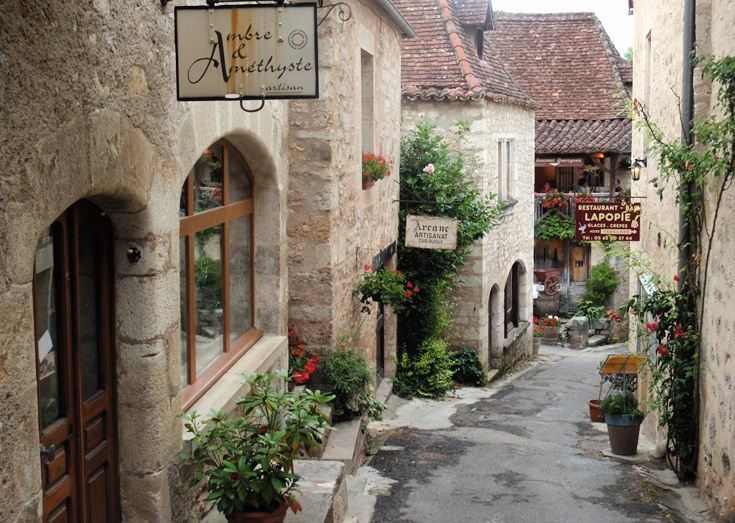
Saint-Cirq-Lapopie
Saint-Cirq-Lapopie (Stage 3: Figeac to Cahors, Célé variante)
Perched on a cliff high above the River Lot, Saint-Cirq-Lapopie enjoys commanding views down to the river and out over the valley beyond. An endless variety of galleries, ateliers and gift stores scattered among the quaint cobbled streets provide the perfect excuse to take a rest day. While you relax, work your way through the wide choice of cafés nestled among the stone walls and flowering vines.
Take a closer look around Saint-Cirq-Lapopie and find a comprehensive list of accommodation.
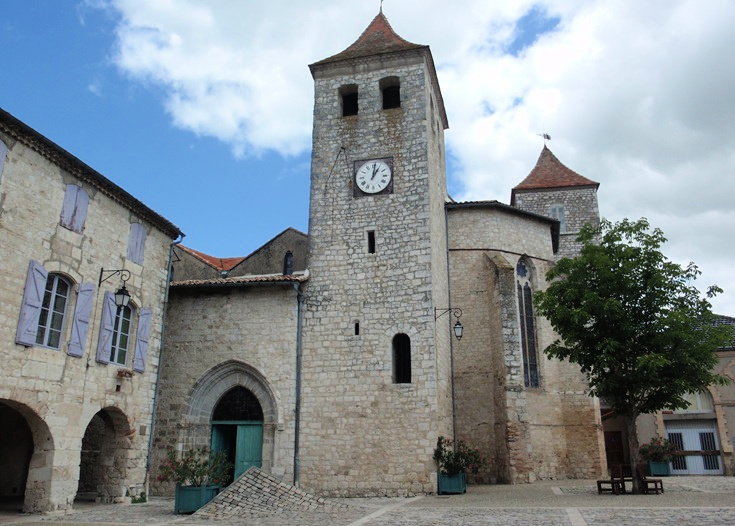
The main square of Lauzerte features an unusual curl in the paving near the church
Lauzerte (Stage 4: Cahors to Eauze)
Towards the end of the twelfth century, two noblemen approached Raymond V, Count of Toulouse, with a proposal to build a château and 200 houses on a hill in the Quercy region. Protected by towers and six gates that controlled the entrance to the town, Lauzerte was the earliest version of the bastide, or fortified town, which provided a strategic defence post for the rulers of the time.
Sadly, the château is no longer standing, but the spectacular setting and charming alleys have long drawn artists to the village. Wander the streets passing galleries and workshops displaying local creations, then settle in at one of the many cafés on Place des Cornières for a refreshing cold drink.
Take a closer look around Lauzerte and find a comprehensive list of accommodation.
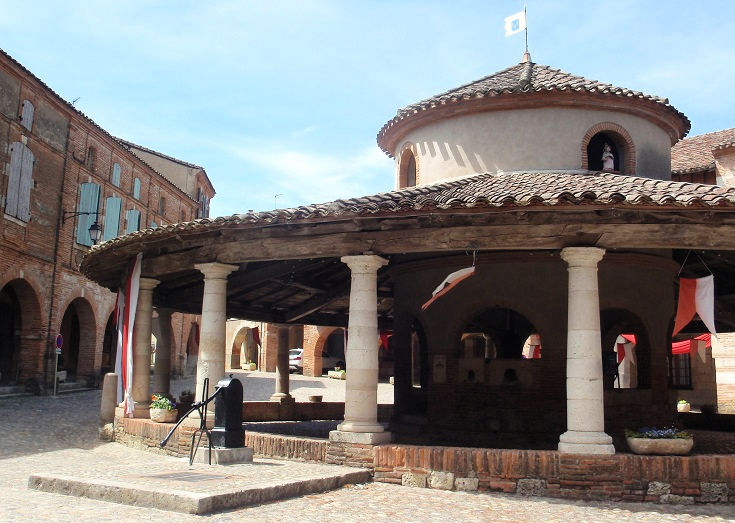
Halle Circulaire in Auvillar
Auvillar (Stage 4: Cahors to Eauze)
The beautiful Halle Circulaire surrounded by a stone and timbered arcade in the centre of Auvillar is one of the best-known landmarks along the Chemin de Saint-Jacques. Join other walkers resting in the cool shade under its wide roof, then head over to the remains of the château where you’ll enjoy stunning views of the GR 65 path as it passes through Espalais.
Take a closer look around Auvillar and find a comprehensive list of accommodation.
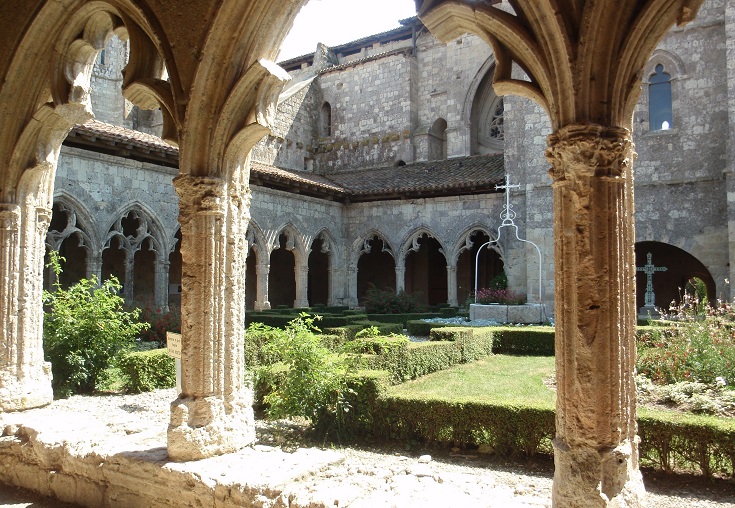
Cloister in La Romieu
La Romieu (Stage 4: Cahors to Eauze)
Allow an hour or two to visit the UNESCO-listed, fourteenth-century church and cloister dedicated to Saint-Pierre in La Romieu. Although a fire destroyed the wooden upper floors of the cloister in 1569 during the Wars of Religion, the delicate stonework of the ground floor arches remains, and frames the lovely garden beds in the centre of the cloister.
From inside the church, it is possible to climb the spiral stone staircase in one of the adjoining towers and enjoy the glorious views over the countryside.
Take a closer look around La Romieu and find a comprehensive list of accommodation.
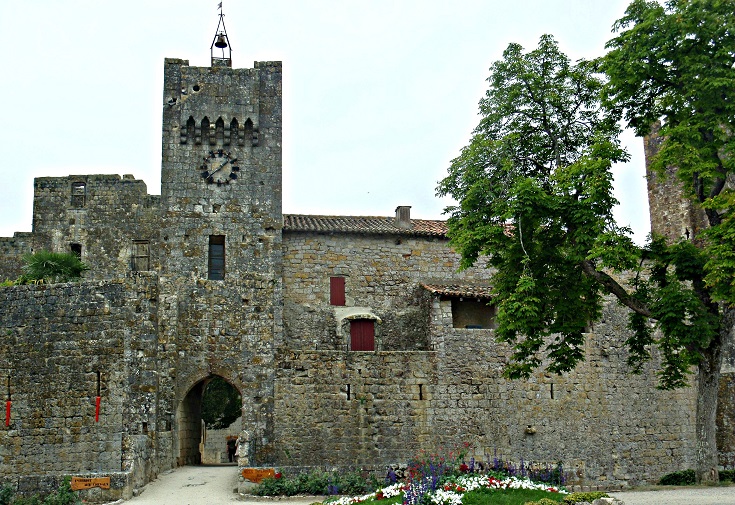
Entrance to the walled village of Larressingle
Larressingle (Stage 4: Cahors to Eauze)
Located one kilometre (0.6 mi) from the GR 65, the fortified village of Larressingle is well worth the detour.
Built in the thirteenth century for the Bishops of Condom, Larressingle is comprised of high stone walls and a dry moat, enclosing a château, church and the houses of the clergy and villagers. Arrive in time to linger over lunch in the shadow of the stone towers, then head into any of the gift shops for a glimpse inside the walls.
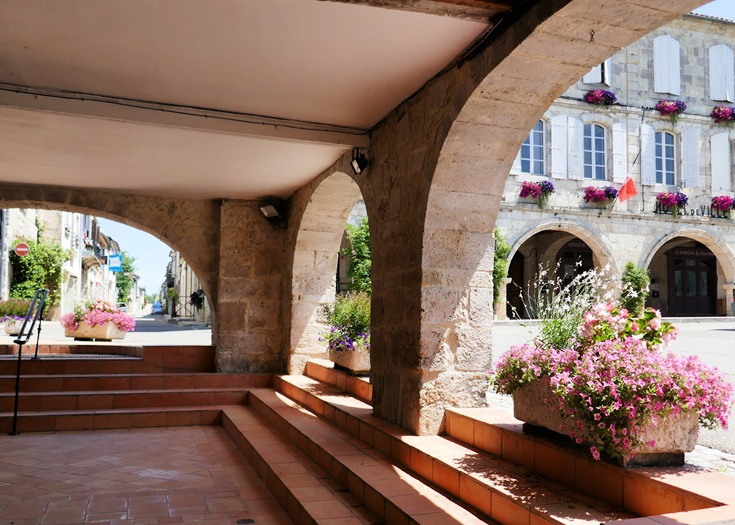
Place de l’Hôtel de Ville, Montréal-du-Gers
Montréal-du-Gers (Stage 4: Cahors to Eauze)
Founded in 1255, Montréal-du-Gers was the first of the bastides, or fortified villages built in the Gers region of France. Despite the fortifications, the village was lost to the English in battle, and reclaimed, several times over the next three centuries.
Ask at the Tourist Office for a map of the town which outlines a short walk around the village, passing the central arcade, quaint alleys and covered walkways.
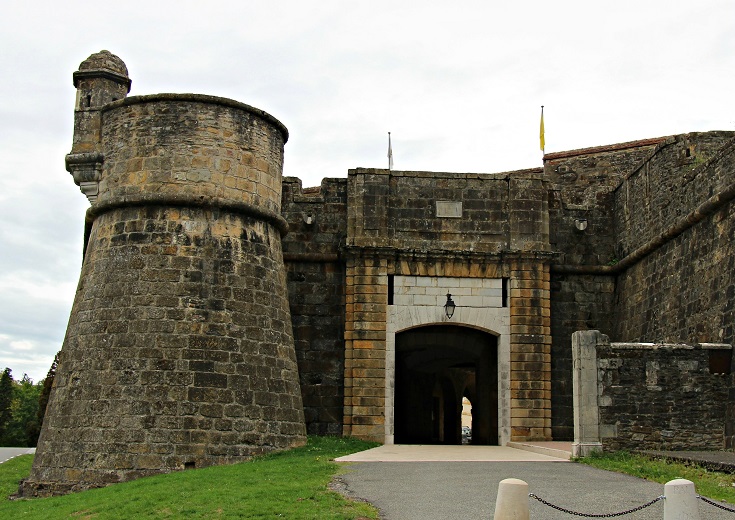
Porte-Antoine, Navarrenx
Navarrenx (Stage 5: Eauze to Saint-Jean-Pied-de-Port)
Like many towns in southern France, Navarrenx was well-settled when the Romans swept through in the first century CE. By the twelfth century, a fortress dominated the eastern bank of the river, but in 1523, it proved no match for the armies of William of Orange. Fifteen years later, the current rampart walls were added and provided a sure line of defence for the villagers throughout a siege lasting four months during the Wars of Religion.
Each evening at 6 pm, walkers gather in front of the church to enjoy a welcoming drink and listen as a local volunteer recounts the history of the church which was rebuilt in the middle of the nineteenth century.
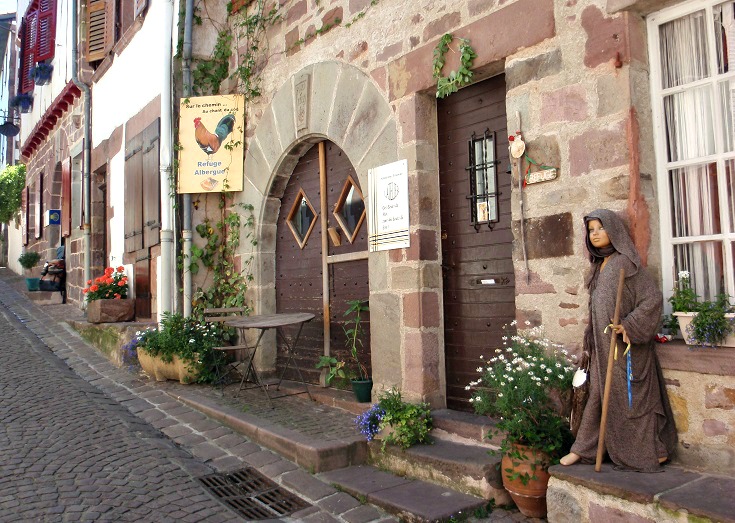
Rue de la Citadelle, Saint-Jean-Pied-de-Port
Saint-Jean-Pied-de-Port (finishing point of the Chemin de Saint-Jacques)
The walk along the Chemin de Saint-Jacques draws to an end in the picture-perfect village of Saint-Jean-Pied-de-Port. Entering the village through Porte Saint-Jacques, the GR 65 continues along Rue de la Citadelle—an impossibly pretty lane lined with chambres d’hôtes, souvenir shops and stores selling anything a pilgrim headed to Santiago could possibly want.
It’s time to relax, rest your tired feet and celebrate a successful journey!
Take a closer look around Saint-Jean-Pied-de-Port and find a comprehensive list of accommodation.
Look inside the CHEMIN DE SAINT-JACQUES DU-PUY (PDF) guidebooks
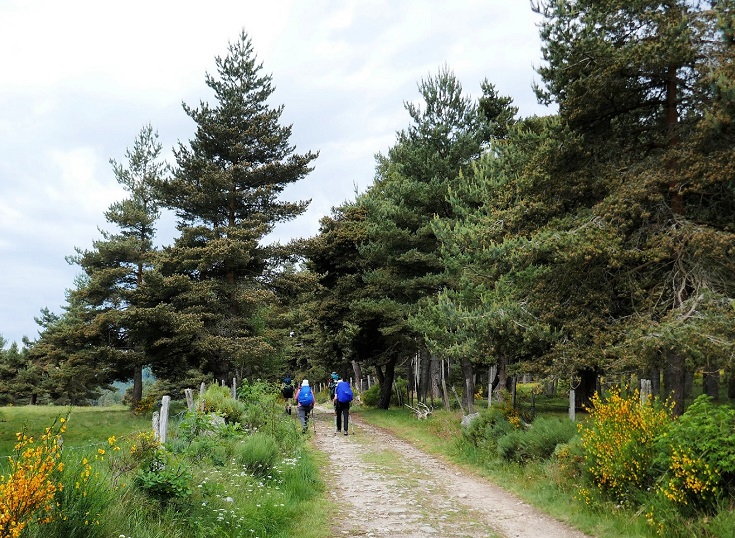
There is no shortage of company on the Chemin de Saint-Jacques du-Puy
Tips for walking the Chemin de Saint-Jacques du-Puy
(Click here for general tips on long-distance walking—preparation, packing and avoiding blisters)
TIP 1: For less-experienced long-distance walkers
The first 200 kilometres (125 miles) from Le Puy-en-Velay to Conques is the perfect walk for less-experienced long-distance walkers to cut their teeth on.
Many first-time walkers are concerned about becoming lost or injured far from town, but there will be lots of other walkers about to keep you company and who will come to your aid if you find yourself stranded along the way.
This section is also well supported with a daily bus service which runs from Le Puy-en-Velay to Conques and back each day, stopping at Montbonnet, Saint-Privat-d’Allier, Monistrol-d’Allier, Saugues, Le Villeret-d’Apchier, Chanaleilles, La Chapelle-Saint-Roch (3 kms beyond Le Sauvage), La Roche, Les Faux, Saint-Alban-sur-Limagnole, Aumont-Aubrac, Les Quatre Chemins, Nasbinals, Aubrac, Saint-Chély-d’Aubrac, Saint-Côme-d’Olt, Espalion, Estaing, Golinhac, Espeyrac and Senergues.
TIP 2: How to plan a long-distance walk
If the thought of planning a long-distance walk feels too complicated, follow this step by step process. I’ve used my walk along the GR 70 Chemin de Stevenson as a case study but the steps can be applied to any long-distance walk.
(And if you rather not do any of the research yourself, you’ll find it all done for you in an I Love Walking in France guidebook )
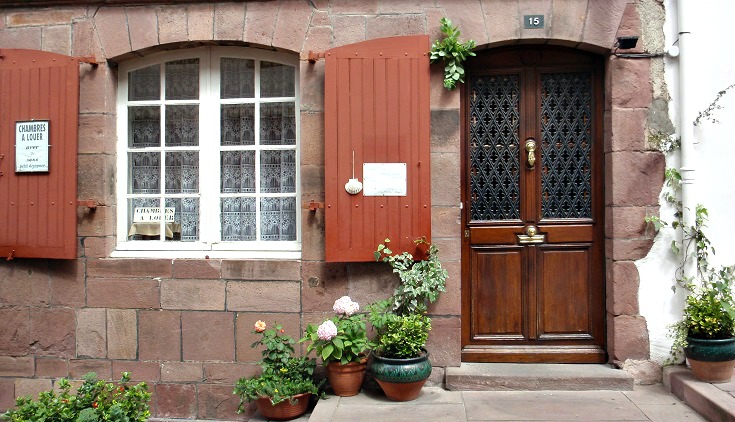
Should I book accommodation in advance?
Most walkers fall squarely into one of two camps when it comes to pre-booking accommodation—those who ALWAYS do and those who can’t imagine why deciding in advance where to stop each night would be a good idea.
I prefer to book ahead but even I find the idea of locking in a 42-day schedule daunting.
Rather than recommend one option over the other, I suggest you consider the following points before committing to either plan:
- If you are having your luggage transferred along the chemin, you’ll need to know where you’d like your bags dropped. All transfer companies advise booking at least one day in advance which allows your schedule to remain fairly loose, but they also point out that transfer vans fill up fast during the peak summer months and on rainy days. They advise against leaving your booking until the last minute.
- Many towns along the Chemin de Saint-Jacques host a busy calendar of festivals and fairs throughout the warmer months attracting visitors from near and far. I’ve sometimes assumed that an annual parade held in honour of an obscure saint would be a low-key affair only to find all beds fully booked months in advance. (If you will be in the Aubrac region during the last week of May when the Transhumance is held, accommodation will need to be booked up to a year in advance.)
- Booking in advance assumes you’ll know how often to take a day off walking—to rest a dodgy knee, allow blisters to recover or simply spend some additional time exploring nearby sights, such as the wineries around Cahors or the village of Rocamadour near Figeac. I confess I usually overestimate my need to rest and sometimes find myself locked into a break when I’d rather be walking.
If you do choose to book accommodation in advance, you may find these tips for booking in French useful.
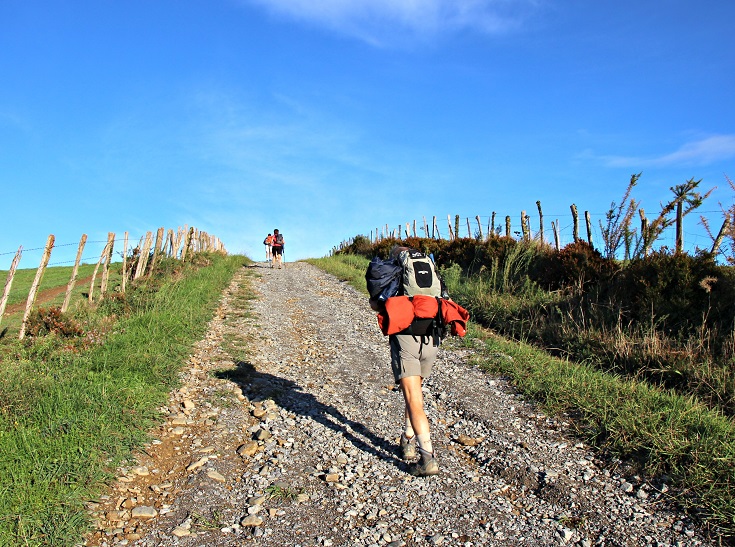
Luggage transfers along the Chemin de Saint-Jacques
Several companies offer luggage and people transfers along the Chemin de Saint-Jacques du-Puy. Each one requires you to leave your bags in the foyer by 8 AM each morning and they will be dropped at your next hotel some time during the afternoon. (If you have a short day of walking planned, it is possible you will arrive before your luggage.)
Each company has slightly different price rates, weight restrictions and operating seasons. If you are walking very early or very late in the season (before mid-April or after mid-October), check carefully that the service is available when you need it.
Of the companies listed below, I use La Malle Postale and Transports Claudine. Both have proved reliable, responsive to questions (the staff at La Malle Postale speak several languages) and very helpful when I needed to veer slightly away from their standard set of drop off points.
La Malle Postale (Le Puy-en-Velay to Lectoure)
Transbagages (Le Puy-en-Velay to Conques)
Transport du Levant (Le Puy-en-Velay to Figeac)
Transport Lample (Le Puy-en-Velay to Moissac)
Transports Claudine (Figeac to Saint-Jean-Pied-de-Port)
Les Valises de Saint-Jacques (Moissac to Saint-Jean-Pied-de-Port)
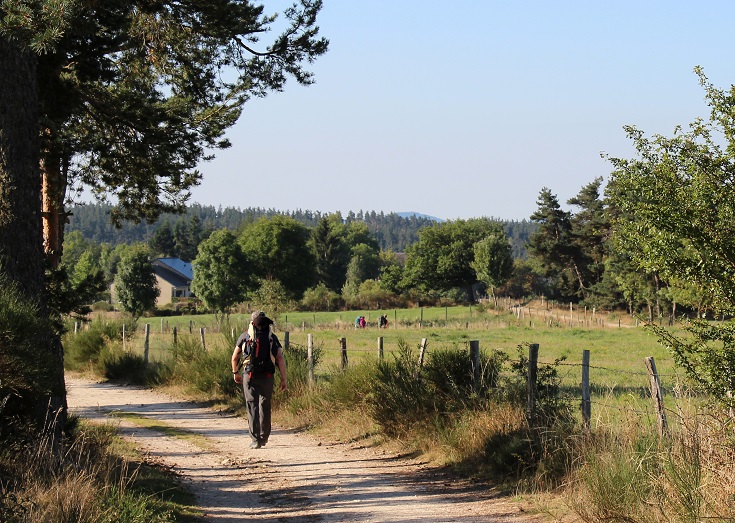
The best time of year to walk the Chemin de Saint-Jacques du-Puy
Walking season in France extends from April through until October. Outside of these months, many areas will be under snow and walking under these conditions carries a set of challenges well beyond my area of expertise. Many hotels will be closed during this period also, making accommodation harder to find.
The peak period for walkers is May through to September. Although daytime temperatures can be quite high in summer, the sunflowers will be blooming as you venture further south (and this is sufficient reason for me to endure a little heat!).
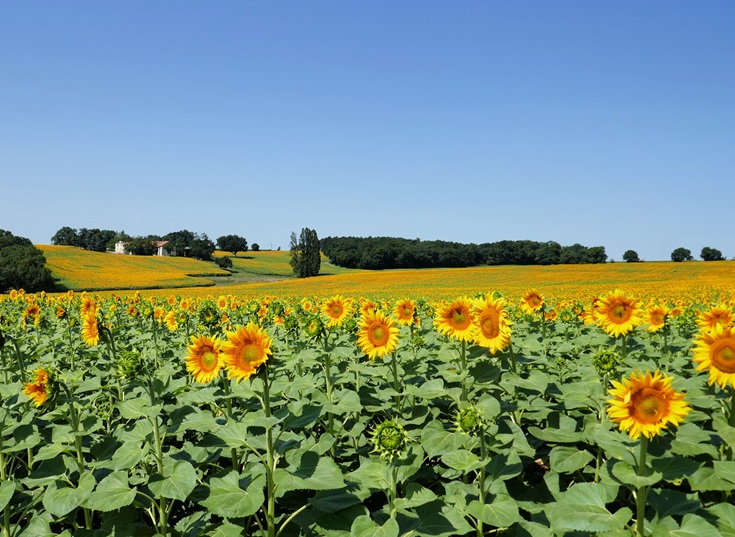
Fields of sunflowers between Larressingle and Montréal-du-Gers (photo taken in early July)
Many villages host an evening market over the summer months and museums and châteaux remain open throughout the day, rarely closing for lunch, which will give you more flexibility if there is an attraction you’d like to visit.
August is traditionally the month when the French take their vacation—including hotel proprietors! This is less common, but not unheard of, in smaller villages and I have not considered walking during this month.
In May and September, temperatures are much milder, and walking is the perfect way to spend the day. But, from my experience, you are more likely to encounter rainy days in May and I now plan all walks for June or September.
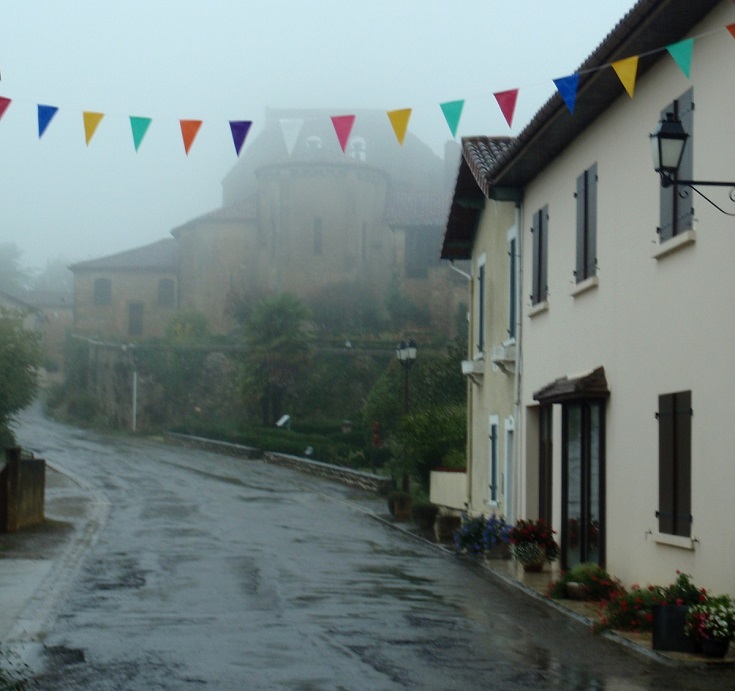
Pimbo on a wet, miserable morning in September
The best guide book for the Chemin de Saint-Jacques du-Puy
…other than an I Love Walking in France guide book, of course!
By far the most common guidebooks carried by walkers I’ve met are the TopoGuide and the Miam Miam Dodo guides. Both are written in French but the layout and map presentations are quite different.
As I walked the Chemin de Stevenson in 2016, I purchased and carried both the TopoGuide and the Miam Miam Dodo guide. I’ve posted a comparison of both guidebooks which includes photos, likes and dislikes and a purchasing guide to help you navigate the online stores (in French).
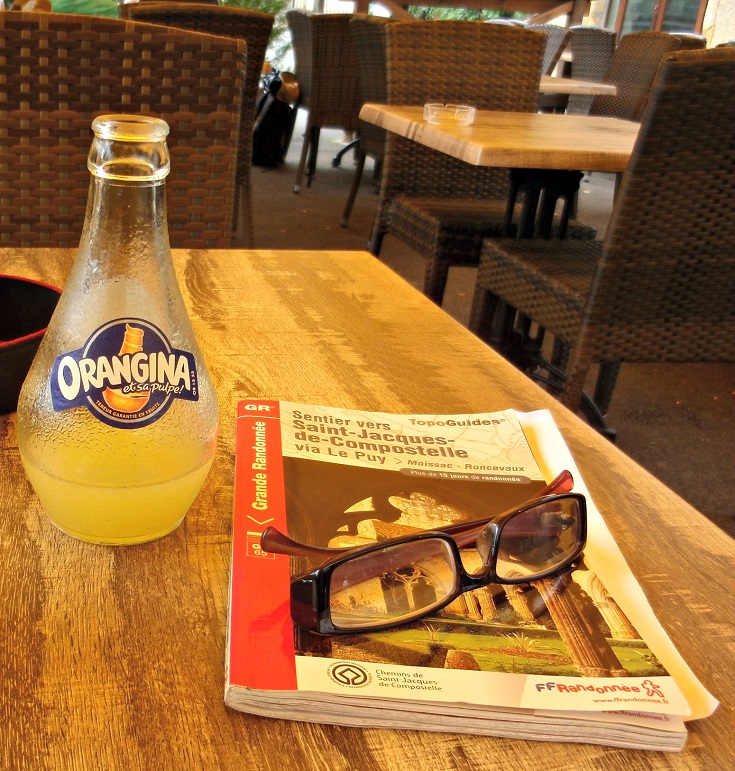
My personal favourite (for any long-distance walk in France) is the TopoGuide as I find the topographic maps enormously helpful for getting a feel for the terrain.
TopoGuides are published by the Fédération Française de la Randonnée Pédestre (FFRP), the non-profit organisation which oversees the maintenance and sign-posting of all long-distance walking paths in France—with the aid of an army of dedicated volunteers. Without their tireless efforts, long-distance walking would not be possible and I am happy to support them by purchasing their guidebooks.
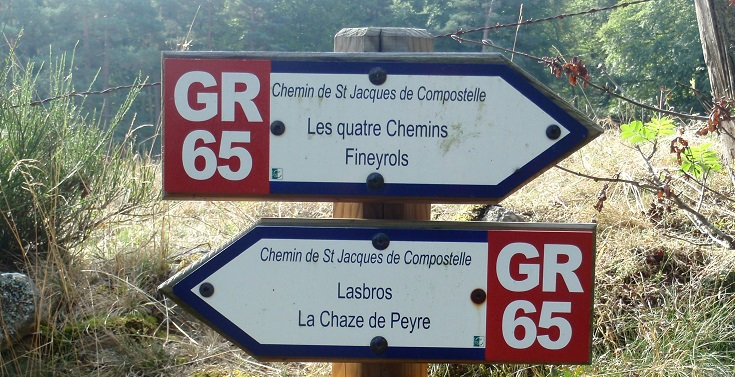
Is it necessary to carry a crédencial (pilgrim’s passport) on the Chemin de Saint-Jacques du-Puy?
No! Along the Spanish Camino, a crédencial IS essential if you wish to stay in the pilgrims’ refugios and as you draw closer to Santiago, competition for a cheap bed can be pretty stiff.
But in France, it is not necessary to show your crédencial when securing a bed at one of the many gîtes along the Chemin de Saint-Jacques. (In France, you are less likely to find yourself stranded or having to walk on to the next town but if accommodation is filling up fast, a crédencial WILL give you priority access over other travellers.)
You can have your crédencial stamped at each of your nightly stops which serves as a lifelong reminder of your journey.
Note: In the last year or so, there has been much discussion along the Camino Françes around the requirements which must be met in order to be called a pilgrim and qualify for the Certificate declaring completion of the Compostella upon reaching Santiago. More recently, this debate has surfaced along the Le Puy route and there are now a handful of gîtes (among the hundreds which service this route) who do not accept bookings more than a day or two in advance, only accept walkers who arrive on foot with a crédencial and do not accept delivery of luggage from transport companies except in exceptional circumstances.
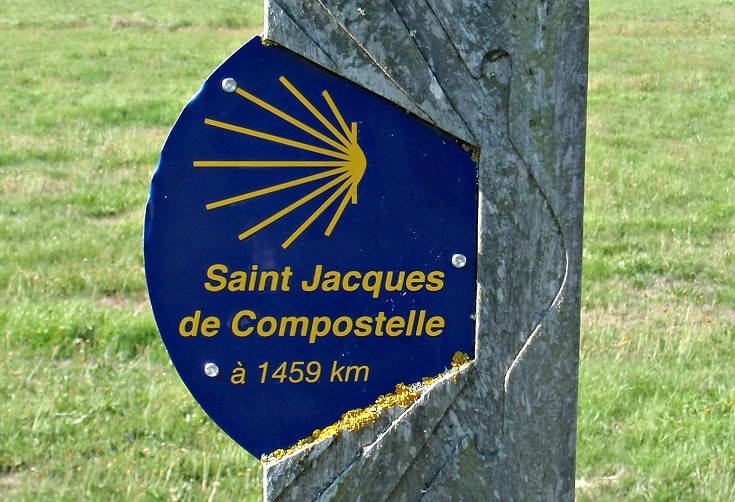
If you walk the entire length of the Chemin de Saint-Jacques from Le Puy-en-Velay, your arrival in Saint-Jean-Pied-de-Port will, no doubt, bring many mixed feelings. There will be relief and gratitude that you’ve arrived safely, that you can sleep in the next morning (and any blisters will begin to heal!). But there will also be sadness that the friends you’ve made over the past weeks will be going their own way—and that tomorrow you’ll return to the ‘real’ world of bus timetables and everyday activities.
Whether you choose to walk the Chemin de Saint-Jacques in sections over many years or in one herculean effort, I can promise you a memorable journey—filled with spectacular scenery, new friends and good food!
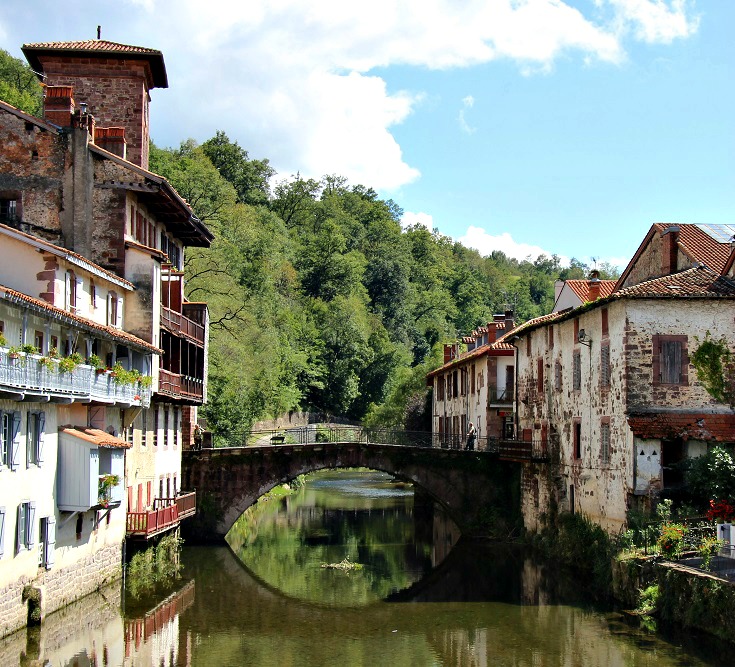
Saint-Jean-Pied-de-Port – end of the Chemin de Saint-Jacques and start of the Camino across Spain
Explore each stage in more depth:
Stage 1: Le Puy-en-Velay to Aumont-Aubrac
Stage 2: Aumont-Aubrac to Figeac
Stage 5: Eauze to Saint-Jean-Pied-de-Port
Purchase one guidebook or the bundle of (PDF) guidebooks covering all five stages
Look inside the CHEMIN DE SAINT-JACQUES DU-PUY (PDF) guidebooks
